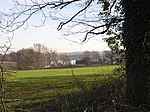West Goscote
Ancient subdivisions of LeicestershireLeicestershire geography stubs
West Goscote was a hundred of Leicestershire, that arose from the division of the ancient Goscote hundred into two. It covers the north west of the county, an area broadly corresponding to the western part of Charnwood district along with North West Leicestershire. The hundred's main town was Loughborough. Other settlements include Ashby-de-la-Zouch, Coalville and Overseal (now in Derbyshire). The hundred was created by the subdivision of the Goscote hundred in 1346.
Excerpt from the Wikipedia article West Goscote (License: CC BY-SA 3.0, Authors).West Goscote
Swannymote Road, North West Leicestershire
Geographical coordinates (GPS) Address Nearby Places Show on map
Geographical coordinates (GPS)
| Latitude | Longitude |
|---|---|
| N 52.75 ° | E -1.3333333333333 ° |
Address
Swannymote Road
Swannymote Road
LE12 9TL North West Leicestershire
England, United Kingdom
Open on Google Maps







